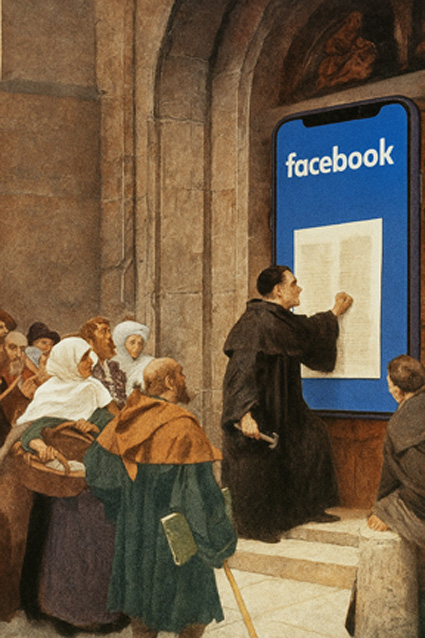Luther on Facebook

𝐇𝐚𝐯𝐞 𝐰𝐞 𝐡𝐚𝐯𝐞 𝐬𝐚𝐧𝐢𝐭𝐢𝐬𝐞𝐝 𝐭𝐡𝐞 𝐑𝐞𝐟𝐨𝐫𝐦𝐚𝐭𝐢𝐨𝐧?
As I have started placing some reviews and writing about issues of concern on Facebook, I've received public rebuke from several friends. I have been told that social media is not the platform to use.
This morning as I contemplated the latest rebuke, I remembered my Church History classes at Theological College.
Martin Luther was remarkably adept at using the latest technologies of his day to advance the Reformation. The most influential among them was the printing press, but several other material and communication innovations also played a role.
Here’s a summary of the key technologies he used or benefited from:
𝟏. 𝐓𝐡𝐞 𝐏𝐫𝐢𝐧𝐭𝐢𝐧𝐠 𝐏𝐫𝐞𝐬𝐬 (𝐌𝐨𝐯𝐚𝐛𝐥𝐞 𝐓𝐲𝐩𝐞) • Invented by: Johannes Gutenberg (mid-15th century, Mainz, Germany).
• Luther’s use: Luther recognized early that print could reach more people than the pulpit. His
pamphlets, sermons, and tracts were printed by the thousands, often in short, affordable
editions that spread rapidly.
• Impact: Within a few years, his 95 Theses (1517) and subsequent writings were circulating
across Europe. Historians estimate that by 1525, over a quarter of all books printed in Germany
were by or about Luther.
𝟐. 𝐏𝐚𝐦𝐩𝐡𝐥𝐞𝐭 𝐚𝐧𝐝 𝐁𝐫𝐨𝐚𝐝𝐬𝐢𝐝𝐞 𝐏𝐫𝐨𝐝𝐮𝐜𝐭𝐢𝐨𝐧
• Technology: Cheap single-sheet prints (broadsides) and small booklets produced on hand
presses.
• Use: Luther and his allies issued accessible vernacular texts, such as Sermon on Indulgence
and Grace (1518), often illustrated with woodcuts for the semi-literate.
• Innovation: Fast turnaround printers could distribute new material within days of a
controversy.
𝟑. 𝐖𝐨𝐨𝐝𝐜𝐮𝐭 𝐈𝐥𝐥𝐮𝐬𝐭𝐫𝐚𝐭𝐢𝐨𝐧𝐬
• Artists: Lucas Cranach the Elder, among others, collaborated with Luther.
• Function: Visual propaganda woodcuts could encapsulate Reformation themes (e.g., Christ vs.
Antichrist series) and communicate theology to common folk who couldn’t read Latin.
• Technology: Reusable carved wood blocks pressed with ink onto paper, later hand-coloured.
𝟒. 𝐋𝐞𝐭𝐭𝐞𝐫𝐩𝐫𝐞𝐬𝐬 𝐓𝐲𝐩𝐨𝐠𝐫𝐚𝐩𝐡𝐲
• Innovation: Metal movable type allowed consistent, durable printing.
• Effect for Luther: His writings could be set, proofed, and reprinted across cities with
minimal revision creating the first truly mass-produced theological discourse.
𝟓. 𝐏𝐨𝐬𝐭𝐚𝐥 𝐍𝐞𝐭𝐰𝐨𝐫𝐤𝐬 𝐚𝐧𝐝 𝐂𝐨𝐮𝐫𝐢𝐞𝐫𝐬
• System: The Imperial Post (Thurn and Taxis network) connected major European cities.
• Use: Luther and his supporters, like Melanchthon, used correspondence to coordinate reform
and share manuscripts swiftly across borders.
𝟔. 𝐕𝐞𝐫𝐧𝐚𝐜𝐮𝐥𝐚𝐫 𝐋𝐚𝐧𝐠𝐮𝐚𝐠𝐞 & 𝐓𝐲𝐩𝐨𝐠𝐫𝐚𝐩𝐡𝐲
• German vernacular printing: Luther’s 1522 September Testament (German New Testament) used
clear Gothic type and straightforward language.
• Result: It became both a linguistic standard and a cultural technology, shaping modern German
identity.
In short, Luther’s genius wasn't inventing new technologies but harnessing the cutting-edge media ecosystem of the 16th century: the printing press, the postal network, and the visual arts to create a spiritual and cultural revolution.